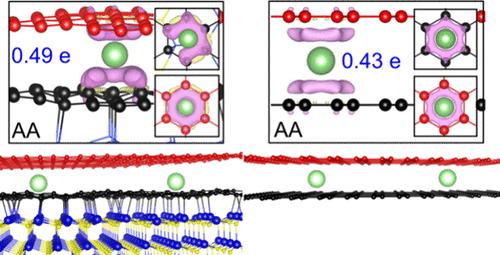当前位置:
X-MOL 学术
›
J. Phys. Chem. C
›
论文详情
Our official English website, www.x-mol.net, welcomes your
feedback! (Note: you will need to create a separate account there.)
SiC Substrate-Enabled Modulation of Li+ Ion Intercalation Thermostability in Strained Bilayer Graphene
The Journal of Physical Chemistry C ( IF 3.3 ) Pub Date : 2024-11-18 , DOI: 10.1021/acs.jpcc.4c05979 Xue Yan, Kaiyun Chen, Gang Kevin Li, Christian Brandl, Jefferson Zhe Liu
The Journal of Physical Chemistry C ( IF 3.3 ) Pub Date : 2024-11-18 , DOI: 10.1021/acs.jpcc.4c05979 Xue Yan, Kaiyun Chen, Gang Kevin Li, Christian Brandl, Jefferson Zhe Liu

|
Two-dimensional (2D) van der Waals (vdW) materials have emerged as vital components in various technological fields. Ion intercalation into vdW materials is a versatile technique for material exfoliation, property induction, and stacking-order manipulation. However, the role of the substrate and its consequential impact on ion intercalation thermodynamics in vdW materials are yet to be well understood. In this work, employing density functional theory (DFT) calculations, we investigate the interplay between the SiC substrate and Li+ ion intercalation in the strained bilayer graphene grown on the SiC (0001) substrate. Our analysis covers five stacking orders (AA, AB, BA, SP, and IM stackings), revealing that the SiC substrate enhances the thermostability of Li+ ion intercalation. This enhancement is attributed to the special sp3-hybrid carbon atoms in the bottom graphene layer. We observed that the SiC substrate promotes selective intercalation with a stacking preference, favoring AA stacking over the other four stackings. Surprisingly, the SiC substrate not only disrupts the crystal symmetry within bilayer graphene, leading to distinctive intercalation behaviors in AB and BA stackings ─absent in free-standing bilayer graphene─but also modulates the Fermi level shift downward by inducing p-type doping to facilitate Li+ ion intercalation. Our study offers a comprehensive understanding of the intricate relationship between substrates and ion intercalation in layered materials, thereby paving the way for tailored applications of layered vdW materials with substrates through ion intercalation.
中文翻译:

SiC 衬底对应变双层石墨烯中 Li+ 离子插层热稳定性的调节
二维 (2D) 范德华 (vdW) 材料已成为各种技术领域的重要组成部分。离子嵌入 vdW 材料是一种用于材料剥离、性能诱导和堆叠顺序操作的通用技术。然而,衬底的作用及其对 vdW 材料中离子插层热力学的相应影响尚不清楚。在这项工作中,采用密度泛函理论 (DFT) 计算,我们研究了 SiC 衬底与 SiC (0001) 衬底上生长的应变双层石墨烯中的 Li+ 离子插层之间的相互作用。我们的分析涵盖五个堆叠顺序(AA、AB、BA、SP 和 IM 堆叠),揭示了 SiC 衬底增强了 Li+ 离子插层的热稳定性。这种增强归因于底部石墨烯层中特殊的 sp3-杂化碳原子。我们观察到 SiC 衬底通过堆叠偏好促进选择性嵌入,比其他四种堆叠更倾向于 AA 堆叠。令人惊讶的是,SiC 衬底不仅破坏了双层石墨烯内的晶体对称性,导致 AB 和 BA 堆叠中独特的插层行为(在独立双层石墨烯中是不存在的),而且还通过诱导 p 型掺杂来调节费米能级向下移动,以促进 Li+ 离子插层。我们的研究全面了解了层状材料中衬底和离子插层之间的复杂关系,从而为通过离子插层将层状 vdW 材料与衬底的定制应用铺平了道路。
更新日期:2024-11-18
中文翻译:

SiC 衬底对应变双层石墨烯中 Li+ 离子插层热稳定性的调节
二维 (2D) 范德华 (vdW) 材料已成为各种技术领域的重要组成部分。离子嵌入 vdW 材料是一种用于材料剥离、性能诱导和堆叠顺序操作的通用技术。然而,衬底的作用及其对 vdW 材料中离子插层热力学的相应影响尚不清楚。在这项工作中,采用密度泛函理论 (DFT) 计算,我们研究了 SiC 衬底与 SiC (0001) 衬底上生长的应变双层石墨烯中的 Li+ 离子插层之间的相互作用。我们的分析涵盖五个堆叠顺序(AA、AB、BA、SP 和 IM 堆叠),揭示了 SiC 衬底增强了 Li+ 离子插层的热稳定性。这种增强归因于底部石墨烯层中特殊的 sp3-杂化碳原子。我们观察到 SiC 衬底通过堆叠偏好促进选择性嵌入,比其他四种堆叠更倾向于 AA 堆叠。令人惊讶的是,SiC 衬底不仅破坏了双层石墨烯内的晶体对称性,导致 AB 和 BA 堆叠中独特的插层行为(在独立双层石墨烯中是不存在的),而且还通过诱导 p 型掺杂来调节费米能级向下移动,以促进 Li+ 离子插层。我们的研究全面了解了层状材料中衬底和离子插层之间的复杂关系,从而为通过离子插层将层状 vdW 材料与衬底的定制应用铺平了道路。


















































 京公网安备 11010802027423号
京公网安备 11010802027423号